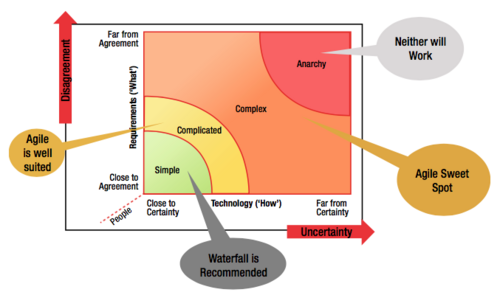The Waterfall Model
Contents |
Abstract
The waterfall model is a Software Development Life Cycle model (SDLC) and was the first process model to be introduced. The waterfall model is easy to understand and use, it is a stage gate model which means that the model consists of stages and gates. Each phase consists of one stage and one gate. Each phase has some pre-determined activities and requirements. The current phase must be completed before the next phase can begin and to end a phase it must pass a gate. A stage is the activities, and the gate is the requirement and the review that determine whether a project can continue. The waterfall model consists of six different stages, 1) Requirements Gathering and Analysis, 2) Systems Development, 3) Systems Implementation and Coding, 4) Testing, 5) Deployment, 6) Systems Operations and Maintenance.
The waterfall model is widely used for software development, but it is also a widely criticized model. The model is often criticized for the late detection of defects in the process and how to handle change requests among other things. It is most optimal to use the waterfall model for simple projects with clear reqirements and projects that do not change through the development process.
About
The first description of the Waterfall model was written by Winston W. Royce in 1970. Back then he did not call it the Waterfall model. [1] Later it got the name because all the phases are done one by one and flows downwards like a waterfall. It is the finest and oldest known Software Development Life Cycle model (SDLC). There are defined and designed various Software Development Life Cycle models such as Spiral model, Big Bang Model, Iterative model etc. These models are also called Software Development Process Models and are all "process consisting of a sequence of planned phases to develop or to amend the software products." [2]
Application of the Waterfall model
To be a good project manager To understand where and when the waterfall model potentially works best an adapted version of Stacey's matrix from Domain I: Agile Principles and Mindset by Sumanta Boral [3] is used. The Stacey Matrix is published and developed by Ralph Douglas Stacey. It is developed to give an understanding of which factors there contributes to complexity and how to address the different degrees of complexity and with that knowledge choose the best suited management action. [4] The Stacey matrix is a two dimensional matrix where uncertainty of the requirements are plottet against the perceived disagreement of the stakeholders. [5] Projects are close to certainty when "How" is well known for example if a similar project, dec have been done in the past and therefor the effect and cause relationship is well known. A project are far from certainty if the project is about something new or innovative because of the uncertainty about the "How" and the unclear relationship
This article introduces
- The waterfall model
- When to use it
- Where to use it
- What each phase consists of
- Best practice
- Pros and cons.
Ref
Petersen K., Wohlin C., Baca D. (2009) The Waterfall Model in Large-Scale Development. In: Bomarius F., Oivo M., Jaring P., Abrahamsson P. (eds) Product-Focused Software Process Improvement. PROFES 2009. Lecture Notes in Business Information Processing, vol 32. Springer, Berlin, Heidelberg. https://doi-org.proxy.findit.cvt.dk/10.1007/978-3-642-02152-7_29
Kramer, Mitch, Best Practices in Systems Development Lifecycle: An Analyses Based on the Waterfall Model (2018). Review of Business & Finance Studies, v. 9 (1) p. 77-84, Available at SSRN: https://ssrn.com/abstract=3131958
http://tryqa.com/what-is-waterfall-model-advantages-disadvantages-and-when-to-use-it/
References
- ↑ Petersen K., Wohlin C., Baca D. (2009) The Waterfall Model in Large-Scale Development. In: Bomarius F., Oivo M., Jaring P., Abrahamsson P. (eds) Product-Focused Software Process Improvement. PROFES 2009. Lecture Notes in Business Information Processing, vol 32. Springer, Berlin, Heidelberg. https://doi-org.proxy.findit.cvt.dk/10.1007/978-3-642-02152-7_29
- ↑ Dubey A.; Jain A.; Mantri A., "Comparative Study: Waterfall v/s Agile Model", International Journal of Engineering Sciences & Research Technology (IJESRT), 2015
- ↑ Boral S.,"Domain I: Agile Principles and Mindset", Ace the Pmi-acp pp. 1-27, 2016
- ↑ Stacey RD. Strategic management and organisational dynamics: the challenge of complexity. 3rd ed. Harlow: Prentice Hall, 2002
- ↑ Boral S.,"Domain I: Agile Principles and Mindset", Ace the Pmi-acp pp. 1-27, 2016
